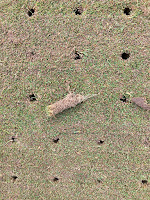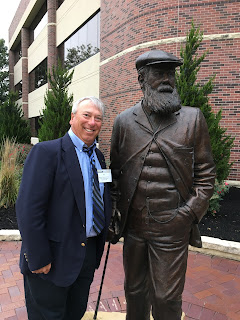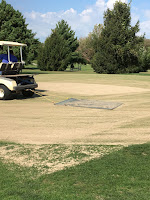Every year I make sure I'm working so our flag is set to honor those that made that sacrifice. I dutiful raise it back to full staff at noon.
It has never been a day of celebration in our family, early on when dad was in the service, chances were, that if he was home, it was only for the day. I do remember (well one of them, the other I was 3) he was definitely gone two of them, the first he was stationed in Goose Bay Labrador, (which kind of plays a big part in our being in the golf business). The second time I do remember him being in Vietnam. It is possible he missed others, but I'm not sure. I'm just grateful that he did come home, and was able to retire at a young age after 20 years (couple in the Navy, the rest in the Air Force. As today we do honor those that served and did not return.
After he retired, it still did not become a day of celebration as our whole family found ourselves in the golf business and we were always working on the holiday so others could enjoy the day. We were fortunate enough to be able to spend time together as a family, since we all worked together at the golf course. So many great memories over all the years. Some great stories to tell for another day.
It started out innocently enough. Mom and Dad bought a house in Florida before he deployed to Vietnam, just north of Tampa, a place dad really liked from the days of painting runways with his dat at MacDill AFB. Spring Hill was just getting started and Mom and I moved in as approximately the 125th family in December of 1968. Spring Hill Country Club opened with 9 holes in the summer of 1969, right as dad arrived back home. Mom who had held many short order cook positions prior (one at a Woolworth lunch counter in DC), was able to get on as the cook at SHCC. As the golf course added a second nine, dad was going to Tampa College, the club decided to add weekend dinners for the members. There were no restaurants at the time in Spring Hill proper, so it was popular, and they would need a bartender on those dinner nights. Enter dad who had learned to tend bar while stationed in Goose Bay. As time went by, they decided to make dad the food and beverage manager, (which meant they could pay him salary, where he joked, he was lucky to make minimum wage with all the hours he worked). He also began working in the pro shop and taking care of the golf cart batteries. When I was old enough to work, I became a cart boy. But I always admired the maintenance staff, and the mowing equipment. After high school I started working on the maintenance crew during summers and part time while attending college. Eventually when at Florida State I could not pass the audition to get into the music school, (at the time I was wanting to be a band director), It was suggested to attend Lake City Community College and go into the golf maintenance profession since I was always working on the golf course, so why not? And here I am today.
My favorite piece of equipment back from those days. It was always my goal to mow fairways with one of these. It took about 4 years and some of our guys retiring our cutting back to part time for me to finally get to run it.
Again, I wish to finish by thanking all the family and friends who had someone in their lives make the ultimate sacrifice. I hope everyone remembers and honors them.
Thanks for reading.
Mel










































